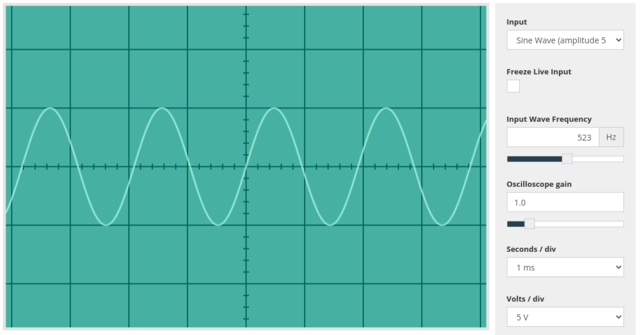Audio frequency
Sound whose frequency is audible to the average human From Wikipedia, the free encyclopedia
An audio frequency or audible frequency (AF) is a periodic vibration whose frequency is audible to the average human. The SI unit of frequency is the hertz (Hz). It is the property of sound that most determines pitch.[1]
| Sound measurements | |
|---|---|
Characteristic | Symbols |
| Sound pressure | p, SPL, LPA |
| Particle velocity | v, SVL |
| Particle displacement | δ |
| Sound intensity | I, SIL |
| Sound power | P, SWL, LWA |
| Sound energy | W |
| Sound energy density | w |
| Sound exposure | E, SEL |
| Acoustic impedance | Z |
| Audio frequency | AF |
| Transmission loss | TL |
The generally accepted standard hearing range for humans is 20 to 20,000 Hz.[2][3][4] In air at atmospheric pressure, these represent sound waves with wavelengths of 17 metres (56 ft) to 1.7 centimetres (0.67 in). Frequencies below 20 Hz are generally felt rather than heard, assuming the amplitude of the vibration is great enough. Sound frequencies above 20 kHz are called ultrasonic.
Sound propagates as mechanical vibration waves of pressure and displacement, in air or other substances.[5] In general, frequency components of a sound determine its "color", its timbre. When speaking about the frequency (in singular) of a sound, it means the property that most determines its pitch.[6] Higher pitches have higher frequency, and lower pitches are lower frequency.
The frequencies an ear can hear are limited to a specific range of frequencies. The audible frequency range for humans is typically given as being between about 20 Hz and 20,000 Hz (20 kHz), though the high frequency limit usually reduces with age. Other species have different hearing ranges. For example, some dog breeds can perceive vibrations up to 60,000 Hz.[7]
In many media, such as air, the speed of sound is approximately independent of frequency, so the wavelength of the sound waves (distance between repetitions) is approximately inversely proportional to frequency.
Frequencies and descriptions
| Frequency (Hz) | Octave | Description |
|---|---|---|
| 16 to 32 | 1st | The lower human threshold of hearing, and the lowest pedal notes of a pipe organ. |
| 32 to 512 | 2nd to 5th | Rhythm frequencies, where the lower and upper bass notes lie. |
| 512 to 2,048 | 6th to 7th | Defines human speech intelligibility, gives a horn-like or tinny quality to sound. |
| 2,048 to 8,192 | 8th to 9th | Gives presence to speech, where labial and fricative sounds lie. |
| 8,192 to 16,384 | 10th | Brilliance, the sounds of bells and the ringing of cymbals and sibilance in speech. |
| 16,384 to 32,768 | 11th | Beyond brilliance, nebulous sounds approaching and just passing the upper human threshold of hearing |



| MIDI note | Frequency (Hz) | Description | Sound file |
|---|---|---|---|
| 0 | 8.17578125 | Lowest organ note | n/a (fundamental frequency inaudible) |
| 12 | 16.3515625 | Lowest note for tuba, large pipe organs, Bösendorfer Imperial grand piano | n/a (fundamental frequency inaudible under average conditions) |
| 24 | 32.703125 | Lowest C on a standard 88-key piano | |
| 36 | 65.40625 | Lowest note for cello | |
| 48 | 130.8125 | Lowest note for viola, mandola | |
| 60 | 261.625 | Middle C | |
| 72 | 523.25 | C in middle of treble clef | |
| 84 | 1,046.5 | Approximately the highest note reproducible by the average female human voice | |
| 96 | 2,093 | Highest note for a flute | |
| 108 | 4,186 | Highest note on a standard 88-key piano | |
| 120 | 8,372 | ||
| 132 | 16,744 | Approximately the tone that a typical CRT television emits while running. |
See also
- Absolute threshold of hearing
- Hypersonic effect, controversial claim for human perception above 20,000 Hz
- Loudspeaker
- Musical acoustics
- Piano key frequencies
- Scientific pitch notation
- Whistle register
References
Wikiwand - on
Seamless Wikipedia browsing. On steroids.